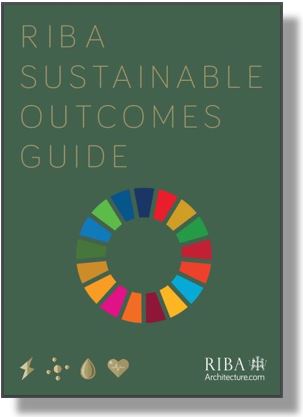The RIBA Plan of Work
 Nothing says “sustainability” like a huge document full of regulatory procedures. The “long awaited” Plan of Work from the RIBA is certainly long (I’m not sure that it was awaited) and weighs in at 143 pages; up from a mere and manageable 37 pages in 2013.
Nothing says “sustainability” like a huge document full of regulatory procedures. The “long awaited” Plan of Work from the RIBA is certainly long (I’m not sure that it was awaited) and weighs in at 143 pages; up from a mere and manageable 37 pages in 2013.
It deals with nine Strategy threads dealing with Conservation, Cost, Fire Safety, Health and Safety, Inclusive Design, Planning, Plan for Use, Procurement and the project’s Sustainability Strategy. It still describes its key role “to provide the project team with a road map for promoting consistency from one stage to the next, and to provide vital guidance to clients undertaking perhaps their first and only building project”, but the changes are significant.
Since its previous iteration in 2013, the RIBA Plan of Work has been a useful guide in steering the profession to provide clear, accurate and timely advice in order to help a project’s procurement and realisation. The new document, used wisely, will continue to do so. However, the additions – too numerous to mention here – have introduced new levels of bureaucratic check-listing that are driven by external political events, rather than the independent practical concerns of the profession.
 The bulk of the new Plan of Work 2020 document is derived from the UK Government’s ambitious targets for net zero by 2050 built into the Climate Change Act of 2008. The Act sets the most stringent environmental reduction targets than any country in the world, resulting recently in the cancellation of the proposed third runway at Heathrow. The courts deemed that this major infrastructure project was – by definition – illegally adding to the sum total of carbon emissions. With immediate effect, Grimshaw Architects’ masterplan for a £14 billion expansion of the airport has been effectively shelved. Beyond that particular project, the principle of not adding to global carbon emissions means that any engineer or architect working on major transport infrastructure that doesn’t meet the exigencies of the Act and its legal and environmental interpretations, could be looking for work very soon.
The bulk of the new Plan of Work 2020 document is derived from the UK Government’s ambitious targets for net zero by 2050 built into the Climate Change Act of 2008. The Act sets the most stringent environmental reduction targets than any country in the world, resulting recently in the cancellation of the proposed third runway at Heathrow. The courts deemed that this major infrastructure project was – by definition – illegally adding to the sum total of carbon emissions. With immediate effect, Grimshaw Architects’ masterplan for a £14 billion expansion of the airport has been effectively shelved. Beyond that particular project, the principle of not adding to global carbon emissions means that any engineer or architect working on major transport infrastructure that doesn’t meet the exigencies of the Act and its legal and environmental interpretations, could be looking for work very soon.
Accompanying the Plan of Work is the RIBA Sustainable Outcomes Guide. This is an additional 51 pages which opens with a quotation from someone called Amor Lovins (sic, Amory Lovins, surely?). These Outcomes are a poor man’s Code for Sustainable Homes (now defunct) and are derived from the UN Sustainable Development Goals.
 Ironically, a large number of the UN Development Goals could never have been achieved without China’s massive carbon-fuelled and energy-intensive growth. China’s development has had a massive impact on global averages for development. Its rapid emergence as a developed nation has lifted so many people out of poverty and hunger and provided hundreds of millions of people with access to clean water, electricity and healthcare, that the UN Development Goals’ global averages have been met without having to worry about meeting the real and desperate needs of the continuing under-developed world. The UN revels in hitting its own global targets by default; through no action on its part.
Ironically, a large number of the UN Development Goals could never have been achieved without China’s massive carbon-fuelled and energy-intensive growth. China’s development has had a massive impact on global averages for development. Its rapid emergence as a developed nation has lifted so many people out of poverty and hunger and provided hundreds of millions of people with access to clean water, electricity and healthcare, that the UN Development Goals’ global averages have been met without having to worry about meeting the real and desperate needs of the continuing under-developed world. The UN revels in hitting its own global targets by default; through no action on its part.
Taking the UN Sustainable Development Goals as a starting point, the RIBA Sustainable Outcomes Guide develops its own versions. For example, under the heading “Wellbeing”, the RIBA suggests that architects should “provide spaces with strong visual connection to outside”. Possibly a window? Under the heading of “Ecology” it suggests that architects should “retain existing natural features”… as opposed to architects’ tendency to wilful destruction perhaps?
Reams of officious micro-interventions seek to nudge the design process in the right direction. If this scuppers any scope for imaginative design, the section on Sustainable Life-Cycle Costing comes to the rescue. Here the architect is enjoined to: “Measure” or “Carry out” certain works to ensure that the sustainable architect can promote the self-sustaining nature of the job by constantly monitoring its own performance. Monitoring requires role reinvention and the new eco-RIBA Plan of Work suggests that clients might appoint an RIBA Client Adviser, a client rep, information manager, Soft Landings (operational performance) champion, Health & Safety adviser, sustainability adviser, operational adviser, asset information adviser, BREEAM adviser, and more. This list, it says, “is not exhaustive”.
The driver, of course, is the RIBA’s Declaration of a Climate and Ecology Disaster and the Chairman of the Sustainable Futures Group has said that “This is our last chance to avert a climate disaster. We must act now.” The Plan of Work 2020 – that’s a guide that is meant to demonstrate how best to run a project – reminds us that “Climate change is the greatest challenge facing us”. So maybe some of us should forget poverty, forget starvation, forget warfare, forget homelessness. The RIBA prefers to regurgitate the Extinction Rebellion motto: “we are in the grips of an environment and climate emergency”. We must prioritise nothing else. Even the UN Goal of “Economic Growth” has been removed from the RIBA’s list of concerns (for architects’ businesses). It is now called “sustainable lifecycle cost”.
In one key section, the authors effectively cut-and-paste the WWF’s claims that “In the past 40 years, there has been a 60% decline in animal populations across the planet.” Just to be clear, “animal populations” is not the same as the total population of particular animals, but simply refers to local herds of animals, for example. (Similarly, “local extinction” sounds like extinction but isn’t). The first question might be, what has this got to do with the Plan of Work? But even on its own terms, as far as we know there are 8.7million species in the world, but the RIBA data is based on WWF data based on the computer-modelling of just 4000 species. The results actually show that some animal groups have declined in certain areas, but it enables the contested concept of “sustainable development” to be positioned as more ethically correct than “development”. This is spin, pure and simple.
However, as a result architectural education – and especially architects’ professional education – will now be forced to endorse one side of an ill-defined, political ideology. Architects and architectural education shall, we are told, “embed key sustainability principles” as a philosophical good. Saving the planet – whatever that means – is now mandated to be the correct moral stance. Development, by which is meant Human Development, is regularly portrayed as the problem. Any ambition to create improved living conditions, quality of life, longevity, or social care of those people who use buildings and the built environment must be secondary to the climate emergency.
It is good that those who are interested in environmental matters show concern for pollution, climate variability and energy efficiency. We all should, I guess. For those who believe that the end-is-nigh, I am happy if you want to don your sandwich board and walk the streets and preach Malthusianism. For more prosaic – but equally ethical – architects who are interested about other issues, they should not be forced to concern themselves with the minutiae of environmental politics, except on a day-to-day matter of efficiency. For example, for those who believe in the independence of political beliefs, freedom of choice, autonomy of moral decision-making, interest in alternatives, desire for open debate, or simply those who wish to prioritise a concern for other matters, let us make our own educated choices about our political development, our intellectual engagement, and our individual design decisions.
.






